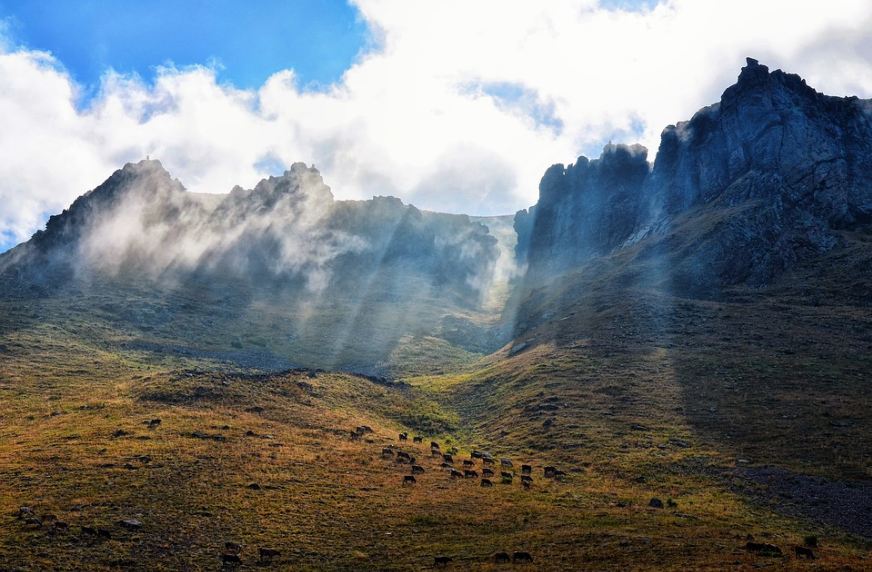Weather is the day-to-day state of the Earth’s atmosphere regarding the different weather components such as temperature, wind, precipitation, atmospheric pressure, humidity, and cloudiness. As we all know, the weather condition is not constant, and it changes every day. Today it might be sunny, and tomorrow might be a rainy day. Written below is the list of different weather conditions that we experience.
Sunny Weather
The sun’s bright beaming rays come out during sunny weather, and the sky is blue and very clear. There are hardly any clouds that show up or maybe none. Since there are no clouds, there will be 0 chance of rain during sunny weather. This is also recognized as fine weather. The temperature could rise significantly when the sun is out, but it can also bring a freezing temperature during the nighttime, especially during the winter season. Temperatures drop at night because there is no presence of clouds that would help keep the radiating heat from going into space. The temperature keeps on decreasing up until the next sunrise.
Most places that experience sunny weather are the deserts.
Cloudy Weather
This weather is also considered fair weather. During cloudy weather, clouds cover the sky, and they block the rays that are coming from the sun. The vast number of clouds also traps the heat from the ground, so there is still heat during this kind of weather. However, the wind blows very gently during this type of weather. Cloudy weather could cause some light rainfalls.
Partially Cloudy Weather
Partially cloudy or partially sunny weather is when few clouds cover the sky, but most parts of the sky are clear and bright. Temperature drops most likely occur for a short period whenever the clouds cover the sun during the daytime. Although there is a presence of clouds, precipitation most likely would not happen during partially cloudy weather.
Overcast Weather
During overcast weather, skies are entirely covered by dim clouds that are usually stratus clouds. When the weather is overcast, there is only a little presence of the sun and the moon, or sometimes there is none at all. The sky might appear in colors like dull-white, light grey, grey, or black during this weather. The temperature during overcast weather usually is the same the whole day; there might be a very light dropping or rising of temperature; this is due to the clouds covering the skies.
Windy Weather
During windy weather, warm air rises and then mixed with the cold air in the atmosphere. This weather is identified by a slight blowing of air and a cold breeze. Most of the trees and objects swing back and forth when it is windy weather.
Rainy Weather
Rainy weather usually occurs when the clouds could not anymore hold the condensed water droplets that it carries, so it falls to the ground in the form of water droplets. During rainy weather, the surroundings might seem a little dark; there is a presence of nimbostratus clouds that cause the sky to dim. An average rain gives off a rain intensity of 0.1 inches per hour, but there are also heavy rains, which are 4 inches per hour.
Stormy Weather
Stormy weathers are produced by the large cumulonimbus clouds, huge clouds, rain-bearing, and are close to the ground. This cloud type has heavy rains, lightning, thunder, hail, strong winds, and tornadoes. This weather must not be taken lightly because it could cause a lot of damage to the affected areas. It could cause immense flooding and strong winds that could blow away heavy objects in your surroundings. Stormy weather often occurs in mountains, tropical countries, and countries that are near the equator.
Snowy Weather
Snow is almost like rain, the water vapor accumulates inside the clouds, and then it condenses. When it gets heavy, and the cloud could not hold it any longer, it falls to the ground in the form of ice crystals. The snow that fell into the ground could remain the same provided that the temperature on the ground would not ascend to more than 0°C.
Snowy weather might seem beautiful, but it could also make life quite difficult. It blocks the roads, decreasing visibility, making it hard to walk or drive. When accompanied by powerful winds, the snow could turn into snowstorms. Snowy weather usually happens in high-altitude mountains and in countries that experience the cold season and have a continental climate.



